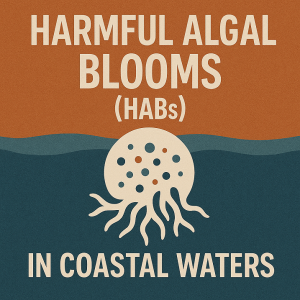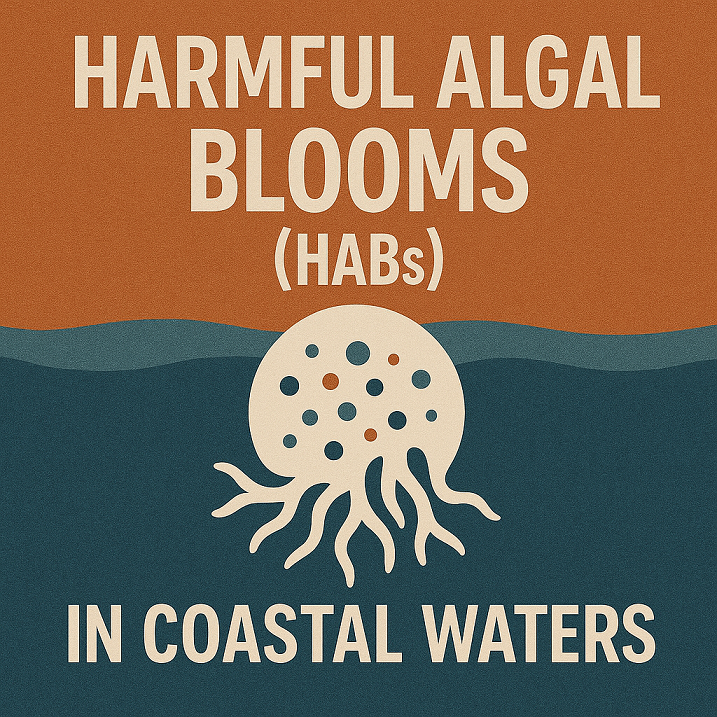Explore the growing threat of Harmful Algal Blooms (HABs) in Eastern Asia’s coastal waters. Discover causes, ecological impacts, maritime risks, and regional mitigation strategies in this in-depth maritime guide.”
Why Harmful Algal Blooms Matter in Maritime Operations and Coastal Ecosystems

If you’ve ever seen patches of red, green, or brown water near a harbor or beach in East Asia, chances are you’ve witnessed a harmful algal bloom (HAB). These outbreaks of microscopic algae may look calm on the surface, but their consequences ripple far and wide—from killing marine life to disrupting fisheries, aquaculture, and even cargo shipping.
In recent years, Eastern Asia has emerged as a global hotspot for HABs. Coastal waters around China, Japan, South Korea, and Taiwan are particularly vulnerable due to rapid urbanization, nutrient pollution, and rising sea surface temperatures. According to the Northwest Pacific Action Plan (NOWPAP) under UNEP, the frequency and intensity of HABs have significantly increased in the past two decades, with major events occurring in the Yellow Sea, East China Sea, and Bohai Sea.
This is not just an environmental problem. For the maritime industry, HABs pose serious operational risks. They clog engine intake systems, corrode hulls, and reduce visibility. For coastal communities, the impact is personal—poisoned seafood, dead fish, and lost income.
Understanding the Science Behind HABs
What Exactly Are Harmful Algal Blooms?
Algae are naturally present in all marine environments, and most are harmless. But under the right conditions—especially excess nutrients and warm water—certain species multiply rapidly, forming “blooms.” Some produce toxins, while others harm marine life by depleting oxygen.
In Eastern Asia, common harmful species include:
- Karenia mikimotoi (Japan, South Korea)
- Chattonella marina (China, Taiwan)
- Alexandrium tamarense (linked to paralytic shellfish poisoning)
These species may form dense swarms visible from satellites, but their impact starts at the microscopic level.
What Triggers HABs in East Asia?
According to a 2022 study in Marine Pollution Bulletin, the primary drivers of HABs in the region include:
- Nutrient runoff from agriculture and urban wastewater (high in nitrogen and phosphorus)
- Warmer sea temperatures, especially in shallow enclosed bays
- Aquaculture activities, which can unintentionally alter nutrient cycles
- Reduced water circulation in artificial harbors and reclaimed coastal areas
China’s Ministry of Ecology and Environment reported that in 2021 alone, over 180 HAB incidents occurred in Chinese waters, affecting nearly 15,000 square kilometers.
Impact of HABs on Marine Ecosystems and Human Activity
Ecological Consequences
When HABs bloom, they can wreak havoc on marine life in several ways:
- Oxygen depletion (hypoxia): As blooms decay, they consume oxygen, creating “dead zones” that suffocate fish and benthic organisms.
- Toxicity: Some algae release neurotoxins and hepatotoxins, affecting fish, shellfish, birds, and even marine mammals.
- Light blockage: Dense blooms block sunlight from reaching seagrass beds and coral reefs, causing additional habitat loss.
These effects are magnified in estuaries and bays where circulation is limited.
Impacts on Fisheries and Aquaculture
HABs are notorious for causing mass fish kills. In Japan and South Korea, HABs have repeatedly wiped out entire harvests of sea bream, abalone, and oysters.
In 2020, a HAB off the coast of South Korea’s South Jeolla Province resulted in over 250 million KRW (around USD 220,000) in losses for the local aquaculture sector (South Korean Ministry of Oceans and Fisheries, 2021).
Shellfish contaminated by toxic algae must be quarantined, affecting export markets and consumer trust.
Maritime Navigation and Shipping
Dense blooms can create visibility hazards for ships near shore. Additionally, algae can clog seawater cooling systems in ship engines, leading to mechanical failure. Ports in HAB-prone areas like Shanghai and Incheon have had to issue special maintenance advisories during bloom seasons.
Moreover, the spread of HAB species through ballast water—as noted in several IMO studies—poses a global risk, leading to the adoption of the Ballast Water Management (BWM) Convention.
Case Studies from the Region
The Yellow Sea (China and South Korea)
The Yellow Sea, bordered by China and the Korean Peninsula, has seen some of the largest HABs in recorded history. A bloom in 2019 covered over 30,000 km² and caused significant disruption to fishing operations.
According to a 2021 paper in Journal of Marine Science and Engineering, nutrient loading from the Yangtze River combined with warm seasonal currents created ideal bloom conditions. Satellite data from MODIS and Sentinel-3 were used to monitor the bloom in real time.
Seto Inland Sea (Japan)
The Seto Inland Sea was infamous for HABs in the 1970s, prompting Japan to introduce strict nutrient management laws. Recent efforts—including the use of bubble curtains and clay dispersal to sink blooms—have reduced frequency, but warming waters are causing resurgence.
The Japan Meteorological Agency and regional marine institutes continue to track blooms with a combination of boat surveys and automated sensor buoys.
Taiwan Strait
Taiwan’s coastal waters frequently suffer from Karenia and Chattonella blooms, affecting both fisheries and tourism. A 2022 event in Taichung saw hundreds of dead fish washed ashore, drawing media attention and prompting calls for stricter water treatment standards.
Regional Monitoring and Management Efforts
National Response Programs
- China has established a tiered HAB response system involving satellite monitoring, field sampling, and early-warning bulletins. The China National Marine Environment Forecasting Center provides public updates during bloom seasons.
- South Korea uses a color-coded HAB alert system (Green, Yellow, Red) and actively supports fishermen with aeration devices and mobile clay dispersal systems.
- Japan incorporates community-based monitoring where fishermen help track bloom spread using apps and visual reporting.
International Cooperation
Through the NOWPAP Harmful Algal Blooms Task Force, countries in the Northwest Pacific share data, host joint training workshops, and develop early warning models. The IOC of UNESCO also supports HAB research through the GlobalHAB initiative.
Technological Developments
- eDNA Monitoring: Water samples analyzed for genetic material allow early detection of bloom-forming species.
- Satellite Remote Sensing: Used for tracking large-scale blooms in real time. Platforms like NASA Ocean Color and Japan’s GCOM-C are vital tools.
- AI-Powered Forecasting: Universities in China and Korea are now experimenting with machine learning models to predict bloom onset based on meteorological and oceanographic data.
Future Outlook: Challenges and Pathways Forward
The outlook is sobering. Climate change is intensifying HABs by warming coastal waters and altering rainfall patterns, which in turn increases nutrient runoff. Coastal development, land reclamation, and increased aquaculture activities further compound the problem.
But there is also hope. Integrated approaches combining policy, science, and technology are emerging:
- Stricter wastewater treatment to reduce nutrient loads.
- Sustainable aquaculture designs to minimize nutrient leakage.
- Cross-border marine spatial planning to anticipate and manage shared risks.
- Public education campaigns, especially in fishing communities, to foster proactive bloom management.
Global frameworks like the UN Sustainable Development Goal 14 (Life Below Water) and conventions like the CBD (Convention on Biological Diversity) are also catalyzing action.
FAQ: Harmful Algal Blooms in Eastern Asia
What causes harmful algal blooms in East Asia?
They’re mainly caused by nutrient pollution, warming water temperatures, and changes in coastal water flow.
Are HABs dangerous to humans?
Yes. Some produce toxins that contaminate seafood and cause illness, such as paralytic shellfish poisoning.
How are HABs monitored?
Governments use satellites, sensor buoys, lab tests, and community reporting to monitor and predict HAB events.
Can HABs be prevented?
While total prevention is difficult, their frequency and intensity can be reduced through better wastewater management and coastal planning.
Do HABs affect global shipping?
Yes, especially through ballast water transport of harmful species and risks to ship cooling systems in bloom-prone waters.
Is ballast water treatment mandatory?
Under the IMO’s Ballast Water Management Convention, ships are required to treat ballast water before discharge.
Conclusion: A Call for Integrated Action
Harmful algal blooms are no longer isolated or occasional events. In Eastern Asia, they’ve become a persistent challenge that connects science, industry, policy, and coastal communities.
For maritime professionals, students, and enthusiasts, understanding HABs is no longer optional. It’s essential to navigating the future of sustainable ocean use. By embracing collaborative monitoring, investing in marine science, and committing to pollution control, we can begin to manage this growing threat more effectively.
As one coastal researcher in Qingdao put it: “The algae may bloom, but so can our response.”
References
- Marine Pollution Bulletin – Elsevier
- UNEP NOWPAP
- IOC UNESCO – GlobalHAB
- IMO Ballast Water Management Convention
- South Korean Ministry of Oceans and Fisheries
- China National Marine Environmental Forecasting Center
- NASA Ocean Color
- Journal of Marine Science and Engineering
- Japan Meteorological Agency
- UN SDG 14
- Convention on Biological Diversity (CBD)

